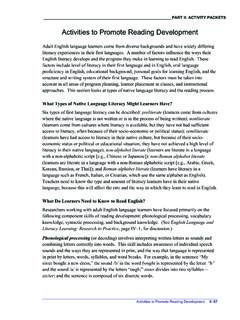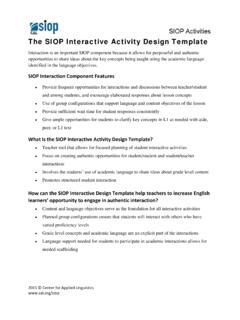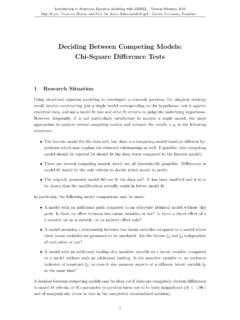Transcription of Program Models and the Language of Initial Literacy in Two ...
1 Program Models and the Language of Initial Literacy in Two-Way Immersion Programs Elizabeth R. Howard Julie Sugarman University of Connecticut Center for Applied Linguistics With the invaluable contributions of David Rogers and Natalie Olague of Dual Language Education of New Mexico ( ). 2009 Center for Applied Linguistics Contact: Julie Sugarman, Retrieved from Two-Way Immersion Program Characteristics At least 50% of instruction is provided in the partner Language ( , Spanish) at all elementary grade levels to all students The Program extends at least five years, preferably K-12 or PreK-12. Both Literacy and content are taught in both the partner Language and English over the course of the Program Instruction is delivered in one Language at a time without translation 2009 CAL 2.
2 TWI Models for Elementary Programs 90/10: The partner Language is used most or all of the day in the primary grades and the partner Language and English are use equally in the later grades 50/50: The partner Language and English are used equally throughout the Program Note. Instructional time includes specials classes (art, music, physical education). Some practitioners also include recess and lunch in the calculation of time in the partner Language and English. National Dual Language Consortium, 2009 CAL 3. Language of Initial Literacy Instruction The Language of Initial Literacy is the Language or languages in which students first learn to read and write in the primary grades (K-2).
3 There are three possibilities for the approach to Initial Literacy instruction All students learn to read in the partner Language first All students learn to read in both languages simultaneously All students learn to read in their native Language first 2009 CAL 4. Option 1: Partner Language First All students learn to read in the partner Language first Usually happens in the context of a 90/10 or 80/20. Program 80-90% of instruction is in the partner Language in Grades K-1 or K-2, with the remaining 10-20% of time devoted to English Language development Language arts in English formally starts in 2nd or 3rd grade Native English speakers and native speakers of the partner Language are integrated for instruction 100% of the day Teachers use flexible grouping and differentiation to meet the needs of native speakers and Language learners 2009 CAL 5.
4 Option 1: Partner Language First Literacy in English is not completely withheld in the first years of the Program Preliteracy and Literacy activities during 10-20% English time Bilingual books Making cross-linguistic connections Reading in English at home Environmental print within and outside of the school 2009 CAL 6. Option 1: Partner Language First Benefits Original TWI/dual Language model Native Language support and development for minority students Immersion in a second Language for majority students Students have one teacher in early elementary grades Strong positive sociolinguistic message about the partner Language and culture Spanish-specific benefits of this approach Research findings: In 90/10 programs, both English- and Spanish- dominant students have higher Spanish proficiency outcomes at the end of the Program than 50/50 students with no detriment to English development in the long run1.
5 Learning to decode text is easier in Spanish because of transparent or shallow orthography (a consistent correspondence between pronunciation and spelling). 1 Lindholm-Leary, K. J., & Howard, E. R. (2008). Language development and academic achievement in two-way immersion programs. In T. W. Fortune & D. J. Tedick (Eds.), Pathways to Multilingualism: Evolving Perspectives on Immersion Education (pp. 177-200). Oxford, UK: Blackwell. 2009 CAL 7. Option 1: Partner Language First Drawbacks All primary grade teachers must be proficient in both Program languages Teachers need to meet different and sometimes competing demands of students from the two native Language groups Can be hard to to parents who speak the partner Language who want their kids to learn English to English parents who worry that their kids will fall behind.
6 Their peers in monolingual English programs Possibility of lower English standardized test scores in the primary grades (before English Language arts is taught formally). compared to students who have more English instruction in their day 2009 CAL 8. Option 2: Both Languages for Everyone All students learn to read in both languages starting in Kindergarten Usually in the context of a 50/50 Program Native English speakers and native speakers of the partner Language are integrated for instruction 100% of the day Teachers maintain separation of languages for instruction (no translation). Skills taught in each Language are coordinated to maximize cross-linguistic transfer and support learning in content areas Teachers use flexible grouping and differentiation to meet the needs of native speakers and 2009 CAL.
7 Language learners 9. Option 2: Both Languages for Everyone Benefits Integrity of TWI/dual Language model is preserved all students receive 50% of instruction through both languages at all grade levels and are integrated 100% of the time Students learn Literacy skills that support the work they do in academic content areas in both languages Literacy development in both languages proceeds at a sufficient pace so that Language skills are sufficient to meet greater academic demands in upper grades Works with either a single teacher teaching both languages or one teacher/one Language approach 2009 CAL 10. Option 2: Both Languages for Everyone Drawbacks Lack of a research base on the effects of simultaneous biliteracy instruction; however, veteran programs that use such a model provide empirical evidence of its effectiveness , Amigos (Cambridge, MA), Key School (Arlington, VA).
8 Requires careful coordination between English and partner Language teacher for Language arts instruction to build on skills previously taught in each Language without repeating Teachers need to meet different and sometimes competing demands of students from the two native Language groups Concern about overwhelming students is this legitimate or a reflection of low expectations for Language learners? 2009 CAL 11. Option 3: Native Language First All students learn to read in their native Language first (English or the partner Language ) before adding Literacy in their second Language Usually happens in a modified 90/10 or modified 50/50 model Students from the two Language groups are separated for instruction for part of the day for the first one to three years of the Program Some schools only separate students into native Language groups for phonics/skills instruction, others for all of Language arts or content areas as well 2009 CAL 12.
9 Option 3: Native Language First Benefits Clear research base supporting native Language Literacy instruction for English Language learners although this is versus English only, not necessarily versus a simultaneous approach; less research base for native English speakers since this is not a typical concern in US schools Easier to target the needs of each Language group in particular, teachers avoid the temptation to water down instruction because of the presence of Language learners Logistical simplification one teacher is responsible for all Initial Literacy instruction for a group of students as opposed to dividing instruction between teachers and languages (although partner teachers should always work to coordinate instruction).
10 2009 CAL 13. Option 3: Native Language First Two different possibilities for what this model looks like, each with its own issues 2009 CAL 14. Option 3a: Native Language First in a 50/50 Context Aside from Literacy instruction, students are in integrated groups and classroom instruction is divided equally between English and the partner Language ( , Spanish). Sample Kindergarten Schedule (300 minutes in a day). Native English Speakers: 90 Native Spanish Speakers: 90. minutes in English minutes in Spanish Everyone: 105 minutes in English Everyone: 105 minutes in Spanish English speakers: 35% Spanish, 65% English Spanish speakers: 65% Spanish, 35% English 2009 CAL 15.










